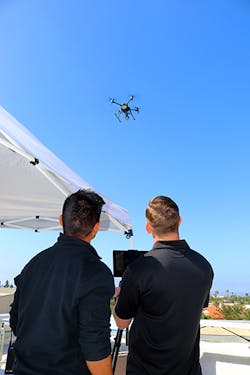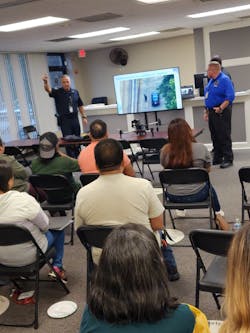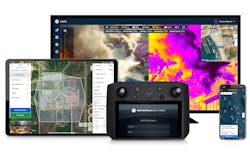When the Chula Vista Police Department in California launched its pioneering Drone as First Responder (DFR) program in 2018, the concept of using drones to proactively respond to emergency calls was relatively unheard of at the time. Just a few months in, it was selected as the only municipal program to be a part of the FAA’s Integration Pilot Program (IPP), designed to help integrate drones into the National Air Space.
This article appeared in the July/August issue of OFFICER Magazine. Click Here to subscribe to OFFICER Magazine.
Unlike traditional drone programs, DFR is proactive rather than reactive. Instead of launching a drone after an officer is already on scene, Chula Vista’s program stations drones at permanent locations throughout the city that respond to emergencies as soon as they happen.
In 2016, when Roxana Kennedy was a captain in the department’s patrol division—just months before she was named police chief later that year—a neighboring agency had a use of force incident that involved a subject experiencing a mental health crisis that ended tragically. Community concerns caused her to examine how officers responded to critical incidents and motivated her to discuss with her lieutenants if there was a better way to provide officers with more information. “Officers need more time to make better-informed decisions before going blindly into a situation and being forced to make split-second decisions,” she tells OFFICER Magazine. “Before we started using sUAS, my agency started by sending plainclothes officers in unmarked vehicles to critical incidents before marked patrol units arrived so these officers could feed information to the responding uniformed officers. This concept began our discussion about how drones could be used in patrol operations instead of plainclothes officers.”In 2018, the Chula Vista Police Department began deploying drones from the rooftop of its headquarters to respond to emergency calls for service, including but not limited to 911 calls and other reports of emergency incidents, such as crimes in progress, fires, traffic accidents and reports of dangerous subjects. The DFR Program continued to expand its capabilities with the ultimate goal of providing the ability to respond to any location in the city within minutes. In May 2019, the FAA authorized the Chula Vista Police Department a Beyond Visual Line of Sight (BVLOS) waiver. This allowed the drones to fly up to 3 miles in any direction from the launch site within city limits. Moving from a 1-mile flight radius to 3 miles increased the area of service exponentially.
In March 2021, the department made history again as the first in the United States to obtain FAA authorization to launch from anywhere in the city. Through business-community partnerships, the Chula Vista Police Department now has a total of five launch sites available and also was the first in the nation to obtain a two-to-one waiver, allowing it to launch two drones from each location. “Flight time is limited for each drone, but having the ability to launch two drones from each location gives us uninterrupted coverage when the community needs us most,” says Kennedy.
The complexity of Chula Vista’s DFR program required a software solution built to meet its needs. It partnered with Motorola Solutions’ CAPE drone software to manage its growing UAS fleet. “We’ve built in many mechanisms, safeguards and controls into the software so responders can focus on getting to the scene and looking at the video, and quickly relaying it back to other responders,” says Chris Bennett, Director of Product Management with Motorola Solutions.Getting the public onboard
According to Kennedy, prior to starting the UAS Program, Chula Vista police officials discussed its plan for UAS operations in the media, in public forums and posted information about the project on its website to allow the public to express concerns or provide feedback.
From the start, the department was sure to make it clear that its UAS policy specifically prohibited the use of UAS for general surveillance. “Our community’s privacy is of the utmost importance, and we are committed to maintaining and protecting the privacy rights of our community,” she says. “The intent of the DFR program is to enhance the department’s response to emergency calls for service. We wanted to make sure our community knew why we were looking into using drone technology. Our initiative and full transparency with the community has enabled us to maintain and continue the great working relationship we have.”
Kennedy says that it is vital that agencies gain the support of their city council and community. “Departments will find that taking the extra effort with outreach to your community will be beneficial and strengthen that relationship.”
She also stressed the importance of offering transparency to the public. The Chula Vista Police Department’s website includes all of the calls for service it responds to with DFR, allowing users to view the date, time, reason for the response and the actual path that the drone flew.
Lt. Abrem Ayana helped found the Brookhaven, Georgia, Police Department’s DFR program, which was approved in October 2020 and had its first flight in April 2021. From the very beginning, he says they engaged the community through various homeowners associations. “We also met with the ACLU and gave a presentation on what our use of drones would look like,” he says. “After we drafted our policy, we provided it to the ACLU and asked for their feedback.”
Ayana says his department continues to engage the community around the drone program through its Citizen’s Police Academy, which is offered in both English and Spanish, at presentations during neighborhood events.
Bennett says the company helps agencies address some of the concerns expressed by the public. “We’ve done this in a couple of different ways. Community feedback prompted the camera to point forward instead of pointing down at houses when it is returning back from a scene. I think that one of our biggest accomplishments is our CAPE Flight History page, providing agencies their own public-facing webpage where 30 minutes to an hour after each flight, visitors to the page can view all drone flight information including where it flew and for what reason. You can see that it went over this neighborhood to respond to a fire and this was the incident number. Similar to how some communities have a 911 call history, we’ve got that for drones.”
Over the last few years, the public has become more accepting of drones used by public safety. Bennett credits this to the efforts put forth by agencies on the forefront of the technology. “If you look at the Chula Vista Police Department, the Brookhaven Police Department and others, they are all a part of a community,” he says. “When they are launching their program, they don’t do it on their own. They join these working groups that see how it’s been successful in other communities. I think where we’ve all been fortunate as an industry and as a community, is that those that have had the most success involve the community and get that buy-in and trust first and then deploy the technology versus trying to convince anyone of the measures in place afterwards.”
Getting off the ground
Kennedy stresses that agencies launching a DFR program must employ a “crawl, walk, run” approach at the beginning. “The city of Chula Vista is 52 square miles, and we can cover most of our city with only five launch locations strategically placed throughout the city,” she says. “To pay for the equipment to run our program we went to our Police Foundation to showcase the benefits of DFR, and they saw the benefits and supported our program. Our police foundation does not pay for staffing. Like many other agencies we are dealing with staffing shortages, so we used salary savings to use officers on overtime.”
Bennett agrees with Kennedy, saying that agencies don’t have to start—and probably shouldn’t start—with the most complex program. “Start with how to get a drone to provide increased situational awareness, get more information when the pilot has visual line of sight on the ground at the incident.”
When creating the program in Brookhaven, Ayana says department’s staff held multiple phone calls and virtual meetings with the Chula Vista Police Department and also met with Flying Lion, who supported Chula Vista’s drone program by providing licensed pilots. “We also conducted a week-long site visit with Chula Vista Police Department, held numerous meetings with the CAPE team, and the team at Skyfire Consulting, who we later contracted to train our pilots and assist with COA applications.”Getting the right support
When the CAPE drone software solution was started back in 2016, the Chula Vista Police Department was its first customer. Bennett says that when it comes to any new technology, it is important to find out which departments are the early adopters that will try to pave way first and have to overcome all of the challenges involved with doing that.
“Chula Vista was the agency that invested the time and resources and had the individuals who had a passion for it who were willing to explore what the constraints were and what the possibilities were for using drones for emergency response,” he says. “It really was just a great partner for us because CAPE was—at the time—a startup that was looking to help these departments more effectively pilot, navigate and ensure the safety of the drones.”
Bennett says that a big feature that CAPE offers agencies is that it is part of Motorola Solutions’ entire suite of investigative and field response software. “Two good examples, one of them includes viewing the drone video as a live stream within CommandCentral Aware. If you are running a Command Center and visualizing all of the cameras and assets throughout the city, that drone video just becomes one additional piece of information in the Command Center. Beyond that, you’ve got CommandCentral Evidence, where should the agencies decide they want to retain the video from the drone and treat that as evidence, they can connect it to that product as well.”
When the Brookhaven Police Department launched its DFR program, Ayana says that CAPE was the only solution on the market that did what his team was looking for and they already had a successful record with the Chula Vista Police Department. He says the CAPE platform provides a high-quality video stream that is steady and reliable. “The safety features that CAPE offers in the way of geo-fencing are very important to us due to our operational environment in controlled airspace. The ability to preset obstacles as well is a big plus of the CAPE software. For us it’s more about the safety features that makes CAPE a good fit for us. The security features of CAPE give us a level of confidence that we can provide that video safely through prudent planning and mapping of geofences and obstacles.”
This article appeared in the July/August issue of OFFICER Magazine.
About the Author
Paul Peluso
Editor
Paul Peluso is the Managing Editor of OFFICER Magazine and has been with the Officer Media Group since 2006. He began as an Associate Editor, writing and editing content for Officer.com. Previously, Paul worked as a reporter for several newspapers in the suburbs of Baltimore, MD.




